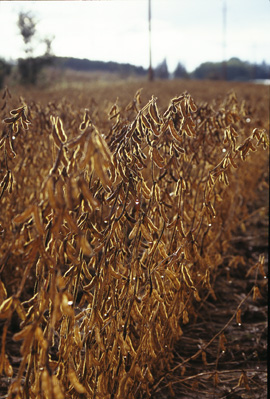
News
Huge potential for soybean traits
Challenge is to convince processors of value.
March 10, 2008 By Ralph Pearce
An important announcement was made late in the summer of 2006: Vistive soybeans, low linolenic varieties were offered to growers for the 2007 growing season. The announcement was significant on several different fronts. First, the variety was being brought to market in answer to requests from Kellogg’s and McDonald’s, two large-scale interests in search of a solution to the trans fat issue challenging food processors and manufacturers. Second, it was commercially available to growers despite the absence of an Ontario based crusher willing to take this variety, which would require segregation, and therefore a premium. And third, this was a consumer related cause-and-effect development. Vistive had been created and then offered to help consumers; it was not a biotech development that only helps growers reduce their costs, a long-time non-farming complaint about biotech endeavours.
 |
| The nearest facility to accept Vistive soybeans from Ontario is located in Zeeland, Michigan, which means trucking costs will negate the bulk of any premiums. |
Now in 2008, the initial success of Vistive’s 10,000 acres in Ontario is brighter with the recognition of key industry players. Monsanto Canada, Thompson Limited and Hyland
Seeds, Soy 20/20 and the Ontario Soybean Growers have come forward with expressed interest in a medium sized, flexible crusher plant for the province, something that would keep Vistive soybeans grown in Ontario, home in Ontario.
Then there is the prospect of Vistive 2 and Vistive 3 soybeans becoming available within the next five to seven years. There is considerable optimism for these developments, the former of which has a mid level oleic acid profile, and the latter, a combination of mid oleic and low linolenic acid profiles. At the 2007 Farm Progress Show in Decatur, Illinois, growers asked why the Vistive 3 soybean, which has many of the same properties as olive oil, is so significant? Olive oil purchased at a grocery store at 23 cents an ounce, it was explained, is more than 10 times the current value of two cents per ounce for soybean oil purchased at the same store.
Beyond these developments, Dan Wright predicts more innovations, particularly for oil components. “Things like Omega 3, which is an oil component that won’t be under a Vistive brand, and high beta conglycinin which isn’t an oil but could be more of a health benefit or more applicable to soy milk or as a filler,” explains Wright, the traits manager for Monsanto in eastern Canada. High beta conglycinin levels in soy beverages do not settle out as much. “And in processed meats, it doesn’t bind to off flavours but absorbs the flavour of whatever you’re making.”
A lot of educating to do
Despite the enormity of such long-term stability for soybean oil, there is the simple hurdle facing Vistive’s growth in Ontario: no provincial crusher is willing to switch from their commodity soybean oil mindset. The road to success in establishing such a crush facility has many twists and turns. It requires education on several levels, including consumers, food processors and manufacturers.
“The trick is to get the consumer demand linked to the processor and then the grower, and then trying to understand that that time frame is a long one,” says Wright. “And then getting food manufacturers to understand that time frame and not just to try to find some quick fix somewhere else.”
Regardless of how long that education process takes, everyone involved in the enhancement of soybean oil agrees the fundamental issue in 2008 is developing a crush facility in Ontario. “We have to have a processor here in Canada to ramp up the acres,” states John Cowan, general manager at Hyland Seeds in Blenheim, Ontario. “We’re talking 10,000 acres right now, but a processor says that production acreage is nothing, that they need up to 70,000 acres to make it worth their while.”
 |
| Developments such as polyols, methyl soyate and a type of soy wax will push the demand for soybeans beyond conventional crush to a ‘flexible’ crush facility in Ontario. |
The problem here is one of perspective. Growers – and seed companies to an extent – ask for a premium to secure supply: the processors demand consistency and quality of supply before they offer premiums. Again, educating the unfamiliar becomes necessary. Cowan points out that historically, buyers who represent processors are not in business to pay premiums; in fact, their success hinges on acquiring their raw materials at the lowest price. That mentality is reflected in consumer buying habits where price is often the predominant purchasing criterion.
“We have to convince the processors and manufacturers that they’re part of the value chain and that they can extract value in this, too,” reasons Cowan. He agrees with Wright’s assessment that education at various levels is required. “Growers and the seed trade and the trait provider are pretty informed on what the process is and who their customers are in terms of oil processing. But I’m not sure the same knowledge goes back to a processing perspective.”
Currently, the closest processing facility accepting Vistive soybeans for crush is in Zeeland, Michigan, on the west-central side of the state. Cowan commends the plant for accepting the soybeans, however, the cost of transportation from points in Ontario negates any benefit that can be derived from a premium.
Present processor links potential prosperity
Jeff Schmalz knows all about present needs leading to success in the future. As executive project director with Soy 20/20 Project in Guelph, Schmalz is well aware of the challenges facing the soybean sector, not just where Vistive is concerned, but with other value-enhanced developments. And the food sector represents the greatest potential in terms of premiums to the grower and benefits through the entire processing and manufacturing chain, and including the consumer.
Consumption of soy proteins is one key indicator, says Schmalz. “The average Canadian eats about 3.25 grams of soy protein per day; in the Orient, the average per capita consumption of soy protein exceeds 25 grams per day,” he notes. “A case can be made that the Oriental diet is healthier. We believe there is an opportunity to increase soy protein consumption in Canada by developing new and unique food products with enhanced levels of soy protein.”
Beyond the enormous upside for food grade soybeans enhancing North American diets, Schmalz agrees with Wright and Cowan on the need for a crush facility in Ontario. In fact, change is sweeping through the industrial processors and chemical manufacturers, and a domestic crusher is the fulcrum on which success in the future is teetering. Polyols, methyl soyate and a type of soy wax are just some of the products being explored.
“A lot of chemical companies in the US are taking a look at what goes into their chemicals,” says Schmalz, predicting emerging markets for new uses for soybeans and other crops. “In 2009, there will be new environmental requirements, the reduction of petroleum based, volatile organic chemicals, and this will create an opportunity for new bio-based solvents, and soy based methyl soyate is one of those.”
However, before there can be success in attracting investors for these innovations, the first order of business is building a dedicated, but flexible medium sized crush facility in Ontario. “If we’re really going to capture the wealth here, we need to be able to crush the beans in this province,” relates Schmalz. “One figure that has been discussed would be a new crushing plant in the range of 1000 tonnes per day. Both ADM in Windsor and Bunge Milling in Hamilton are three to four times that size and can crush both soybeans and canola. A 1000 tonnes per day facility might cost around $25 million. And if you were into biodiesel alongside it, you can double that figure.”
 |
| Success in soybeans will hinge on attracting more consumers to the benefits for soy foods, and building demand for chemical solvents and compounds, car parts and biofuels. |
That secondary product issue is another facet that must be considered, Schmalz adds. A dedicated, domestic crush facility would give growers a direct market for their value added identity preserved soybeans, but there is more to that facility than just oil and meal. “You have to work both ends of that plant, so while we need that crush facility, we also need the businesses surrounding soybeans,” he says. “Businesses like that are not for the faint of heart. They’re often low margin, but they are large scale, and you’re not going to shut down their operation to put 10,000 acres of soybeans through one of their facilities.”
Future imposition?
On a very positive note, if patience is a virtue, good times may be close at hand. Reports of government acceptance of studies by Monsanto and other groups that confirm the benefits of low saturated fats, and linking those to enhanced soybean varieties, may prompt government ministries to establish new food standards. “I’m thinking that two years down the road, the government could say to the processors and food manufacturers, ‘You’re going to have to do this, and use these farm-based products, because we say you have to’,” predicts Cowan.
If that happens, the short-term probability of an Ontario based crush facility being built would be much higher. -end-
There is a huge potential for soybeans in Ontario. I feel that producers will be growing soybean varieties for specific markets. The general idea that soybeans are for animal feed and oil will be gone. Grahame Hardy, Inkerman, Ontario.
Eventually, consumers demand what they want in health benefits at prices they find acceptable. The processors and retailers will meet their needs, but I am not sure farmers will see much in the way of increased income. When we grow any crop, whether it is specialty trait or otherwise, we always strive for the best yield possible using the lowest input costs.
We also understand that any crusher must have enough volume of any specialty crop to justify changing over its facility. Perhaps we will see new smaller operations that will process specialty runs. We may find ourselves dealing with these if they develop. Lennie Aarts, Wainfleet, Ontario.